University M.Ed. Report: Traditional vs. Innovative Learning Spaces
VerifiedAdded on 2021/06/18
|14
|3824
|24
Report
AI Summary
This report, prepared for a Master of Education program, investigates the impact of different learning environments on student outcomes and teacher experiences. It begins with a literature review that examines the effects of design and quality on student engagement and achievement, highlighting the benefits of flexible learning spaces and the importance of considering various pedagogical approaches. The report then outlines the research methodology, which employs a quantitative survey design to gather data from primary school teachers, exploring their perspectives on the advantages and disadvantages of both traditional and innovative learning settings. The report also details the research methodology, including the use of closed-ended questions and Likert scales to collect quantifiable data from educators. The study aims to provide insights into how teachers are professionally supported in flexible learning spaces, contributing to the understanding of effective educational practices. The report also discusses the research philosophy, the strengths and limitations of the chosen methods, and the process of data collection and analysis.

Running head: MASTER OF EDUCATION
MASTER OF EDUCATION
Name of the Student
Name of the University
Author note:
MASTER OF EDUCATION
Name of the Student
Name of the University
Author note:
Paraphrase This Document
Need a fresh take? Get an instant paraphrase of this document with our AI Paraphraser

1MASTER OF EDUCATION
Table of Contents
Step 1:.........................................................................................................................................2
Step 2:.........................................................................................................................................5
Step 3:.........................................................................................................................................6
Step 4:.........................................................................................................................................9
Step 5 :......................................................................................................................................10
Reference:................................................................................................................................12
Table of Contents
Step 1:.........................................................................................................................................2
Step 2:.........................................................................................................................................5
Step 3:.........................................................................................................................................6
Step 4:.........................................................................................................................................9
Step 5 :......................................................................................................................................10
Reference:................................................................................................................................12

2MASTER OF EDUCATION
Step 1:
There has been a wealth of literature that has reviewed the direct impact of the
capacity of design and quality on the outcome of the engagement of and achievement
students in the classroom. The strength of innovative learning environment is that it is
capable of adapting and evolving the practise of education (Watters and Ginns 2000) This
concept of flexible learning environment is considered to revolutionary by the scholars as it
promote deeper interest among students towards learning that is facilitated through the
physical changes. Scholars have argued that the traditional space of teaching can be
improved through the appreciation of the different approaches to learning and teaching
(Pegrum, Oakley, G. and Faulkner 2013). Neill and Etheridge discuss about the designing of
the learning space and the inclusion of pedagogy, instructional technology and physical
design that would foster the different kinds of pedagogical approaches. The authors argued
that achieving that kind of goal demands a flexible learning space in the classroom. The
illustration of this would be transforming the physical space from the traditional setting
exemplified with chairs and tables to new classrooms with IT infrastructure. Another aim of
the researchers was to encourage pedagogical shift from the teacher to the student that would
adopt a collaborative and self-directed method through the involvement of groups and the
social learning communities. Scholars are of the view that pedagogical innovations require a
space that allows the exploration of both the student and the teacher. In order to be effective,
the highlight of the space should be to enable various modes of learning and instruction
(Albion and Gibson 2000). Some of the learning space understood by the researcher is, linear
that is facilitated through lecturer video and presentation; horizontal, that is, facilitated
through class discussion; cluster, that is, facilitated through activities and small group
discussions, and network, that is facilitated through decentralized instruction. Scholars argue
that faculty regarding their room functional usage deploys a variety of pedagogical
Step 1:
There has been a wealth of literature that has reviewed the direct impact of the
capacity of design and quality on the outcome of the engagement of and achievement
students in the classroom. The strength of innovative learning environment is that it is
capable of adapting and evolving the practise of education (Watters and Ginns 2000) This
concept of flexible learning environment is considered to revolutionary by the scholars as it
promote deeper interest among students towards learning that is facilitated through the
physical changes. Scholars have argued that the traditional space of teaching can be
improved through the appreciation of the different approaches to learning and teaching
(Pegrum, Oakley, G. and Faulkner 2013). Neill and Etheridge discuss about the designing of
the learning space and the inclusion of pedagogy, instructional technology and physical
design that would foster the different kinds of pedagogical approaches. The authors argued
that achieving that kind of goal demands a flexible learning space in the classroom. The
illustration of this would be transforming the physical space from the traditional setting
exemplified with chairs and tables to new classrooms with IT infrastructure. Another aim of
the researchers was to encourage pedagogical shift from the teacher to the student that would
adopt a collaborative and self-directed method through the involvement of groups and the
social learning communities. Scholars are of the view that pedagogical innovations require a
space that allows the exploration of both the student and the teacher. In order to be effective,
the highlight of the space should be to enable various modes of learning and instruction
(Albion and Gibson 2000). Some of the learning space understood by the researcher is, linear
that is facilitated through lecturer video and presentation; horizontal, that is, facilitated
through class discussion; cluster, that is, facilitated through activities and small group
discussions, and network, that is facilitated through decentralized instruction. Scholars argue
that faculty regarding their room functional usage deploys a variety of pedagogical
⊘ This is a preview!⊘
Do you want full access?
Subscribe today to unlock all pages.

Trusted by 1+ million students worldwide

3MASTER OF EDUCATION
approaches. This is in juxtaposition to the context of traditional classrooms where there has
been no difference in the usage of rooms. Faculties in the traditional classroom position
explicit teaching along with the use of cluster configurations and horizontal configurations
and the usage of both of these have been found to be equal by a section of scholars working
on this area (McLoughlin 2013). Scholars have argued flexibility of the room is positively
correlated to the engagement of students in the classroom (Chen, Lambert and Guidry 2010).
It was further found that the classroom setting fostered collaborative learning and facilitated
teaching and learning styles of the teachers. With the proliferation in the innovative teaching
and learning practises, researchers need to focus on the physical space. According to
environmental psychologists, the importance of physical space is being increasingly
recognized and it can be found that it has both positive and negative impact on the learning
outcome of the student. As has been stated through research, flexible learning environment
plays a crucial role in the learning outcome of the students. This is witnessed in the form of
flexibility in learning, grasping, engagement of the students and collaboration. Despite the
introduction and adoption of flexible learning spaces, it has been found that the traditional
learning space in the classroom has no alternative for enriching the learning outcome of the
students.. It is the teacher who enjoys the absolute power in deciding on the study materials
and it largely leads to a one-way communication (Sun and Rueda 2012). On the other hand,
the flexible learning setting is premised on the principles of collaboration and advocates
delete the autonomy of the students by rendering them agency in the process of learning.
Researchers have identified that communication strategy is imperative to establish awareness
of the room and thereby train the faculties on the room features they would seek for the
purpose of teaching and learning. Studies have shown that the awareness about the room
informs the faculty about the different kinds of ways to utilize the room and tap the
advantages of the features and the functionality. There should be consideration regarding
approaches. This is in juxtaposition to the context of traditional classrooms where there has
been no difference in the usage of rooms. Faculties in the traditional classroom position
explicit teaching along with the use of cluster configurations and horizontal configurations
and the usage of both of these have been found to be equal by a section of scholars working
on this area (McLoughlin 2013). Scholars have argued flexibility of the room is positively
correlated to the engagement of students in the classroom (Chen, Lambert and Guidry 2010).
It was further found that the classroom setting fostered collaborative learning and facilitated
teaching and learning styles of the teachers. With the proliferation in the innovative teaching
and learning practises, researchers need to focus on the physical space. According to
environmental psychologists, the importance of physical space is being increasingly
recognized and it can be found that it has both positive and negative impact on the learning
outcome of the student. As has been stated through research, flexible learning environment
plays a crucial role in the learning outcome of the students. This is witnessed in the form of
flexibility in learning, grasping, engagement of the students and collaboration. Despite the
introduction and adoption of flexible learning spaces, it has been found that the traditional
learning space in the classroom has no alternative for enriching the learning outcome of the
students.. It is the teacher who enjoys the absolute power in deciding on the study materials
and it largely leads to a one-way communication (Sun and Rueda 2012). On the other hand,
the flexible learning setting is premised on the principles of collaboration and advocates
delete the autonomy of the students by rendering them agency in the process of learning.
Researchers have identified that communication strategy is imperative to establish awareness
of the room and thereby train the faculties on the room features they would seek for the
purpose of teaching and learning. Studies have shown that the awareness about the room
informs the faculty about the different kinds of ways to utilize the room and tap the
advantages of the features and the functionality. There should be consideration regarding
Paraphrase This Document
Need a fresh take? Get an instant paraphrase of this document with our AI Paraphraser
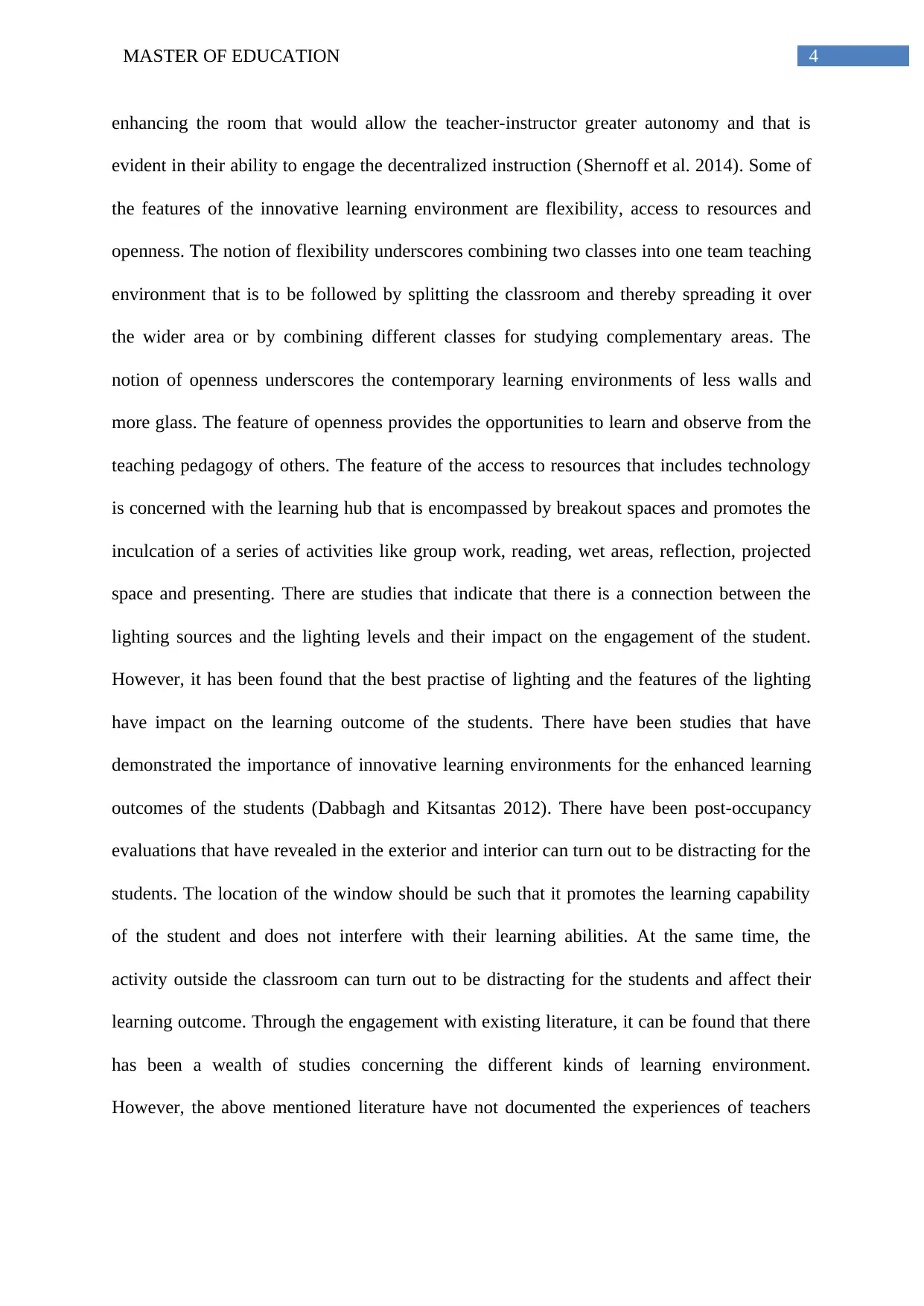
4MASTER OF EDUCATION
enhancing the room that would allow the teacher-instructor greater autonomy and that is
evident in their ability to engage the decentralized instruction (Shernoff et al. 2014). Some of
the features of the innovative learning environment are flexibility, access to resources and
openness. The notion of flexibility underscores combining two classes into one team teaching
environment that is to be followed by splitting the classroom and thereby spreading it over
the wider area or by combining different classes for studying complementary areas. The
notion of openness underscores the contemporary learning environments of less walls and
more glass. The feature of openness provides the opportunities to learn and observe from the
teaching pedagogy of others. The feature of the access to resources that includes technology
is concerned with the learning hub that is encompassed by breakout spaces and promotes the
inculcation of a series of activities like group work, reading, wet areas, reflection, projected
space and presenting. There are studies that indicate that there is a connection between the
lighting sources and the lighting levels and their impact on the engagement of the student.
However, it has been found that the best practise of lighting and the features of the lighting
have impact on the learning outcome of the students. There have been studies that have
demonstrated the importance of innovative learning environments for the enhanced learning
outcomes of the students (Dabbagh and Kitsantas 2012). There have been post-occupancy
evaluations that have revealed in the exterior and interior can turn out to be distracting for the
students. The location of the window should be such that it promotes the learning capability
of the student and does not interfere with their learning abilities. At the same time, the
activity outside the classroom can turn out to be distracting for the students and affect their
learning outcome. Through the engagement with existing literature, it can be found that there
has been a wealth of studies concerning the different kinds of learning environment.
However, the above mentioned literature have not documented the experiences of teachers
enhancing the room that would allow the teacher-instructor greater autonomy and that is
evident in their ability to engage the decentralized instruction (Shernoff et al. 2014). Some of
the features of the innovative learning environment are flexibility, access to resources and
openness. The notion of flexibility underscores combining two classes into one team teaching
environment that is to be followed by splitting the classroom and thereby spreading it over
the wider area or by combining different classes for studying complementary areas. The
notion of openness underscores the contemporary learning environments of less walls and
more glass. The feature of openness provides the opportunities to learn and observe from the
teaching pedagogy of others. The feature of the access to resources that includes technology
is concerned with the learning hub that is encompassed by breakout spaces and promotes the
inculcation of a series of activities like group work, reading, wet areas, reflection, projected
space and presenting. There are studies that indicate that there is a connection between the
lighting sources and the lighting levels and their impact on the engagement of the student.
However, it has been found that the best practise of lighting and the features of the lighting
have impact on the learning outcome of the students. There have been studies that have
demonstrated the importance of innovative learning environments for the enhanced learning
outcomes of the students (Dabbagh and Kitsantas 2012). There have been post-occupancy
evaluations that have revealed in the exterior and interior can turn out to be distracting for the
students. The location of the window should be such that it promotes the learning capability
of the student and does not interfere with their learning abilities. At the same time, the
activity outside the classroom can turn out to be distracting for the students and affect their
learning outcome. Through the engagement with existing literature, it can be found that there
has been a wealth of studies concerning the different kinds of learning environment.
However, the above mentioned literature have not documented the experiences of teachers
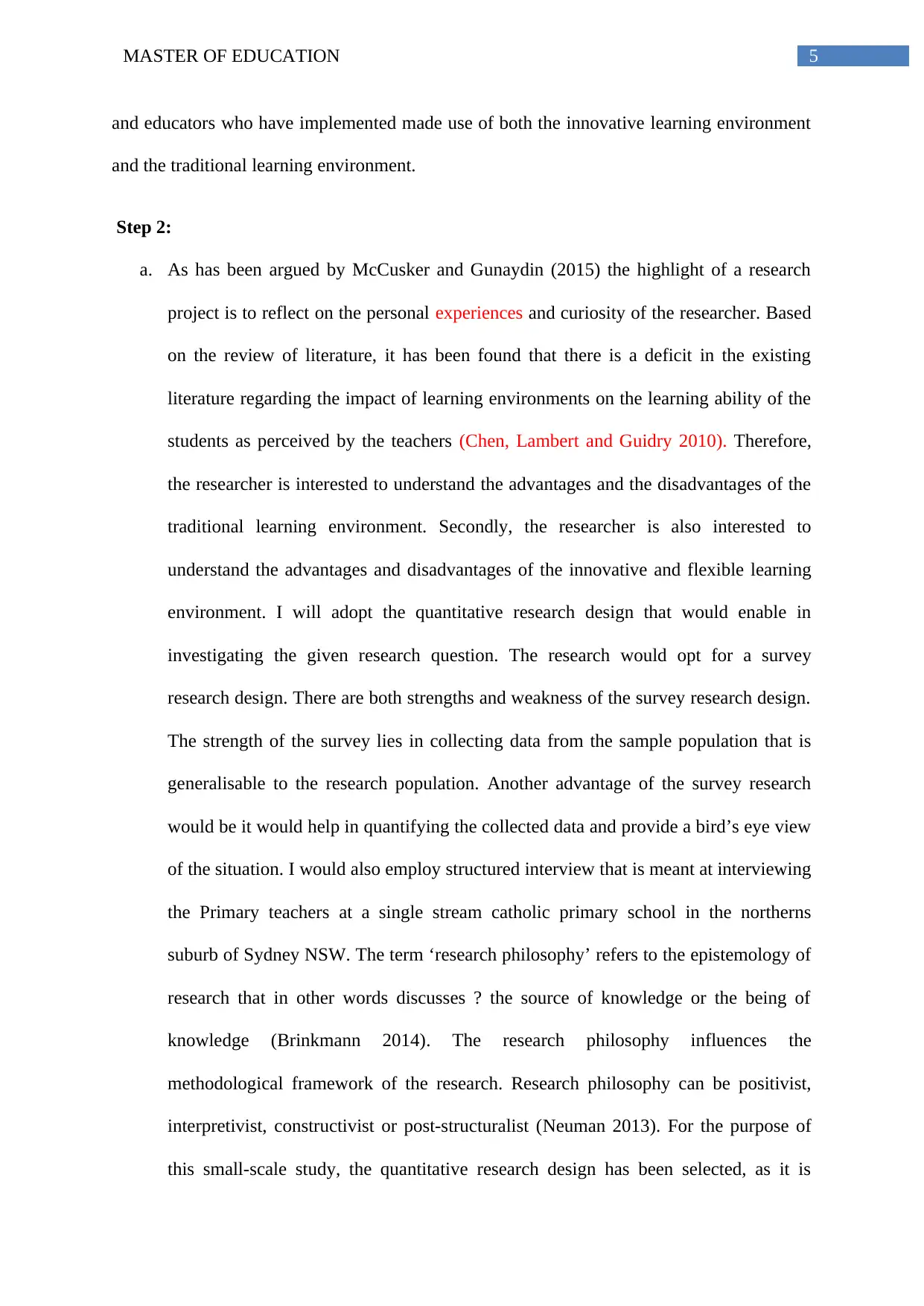
5MASTER OF EDUCATION
and educators who have implemented made use of both the innovative learning environment
and the traditional learning environment.
Step 2:
a. As has been argued by McCusker and Gunaydin (2015) the highlight of a research
project is to reflect on the personal experiences and curiosity of the researcher. Based
on the review of literature, it has been found that there is a deficit in the existing
literature regarding the impact of learning environments on the learning ability of the
students as perceived by the teachers (Chen, Lambert and Guidry 2010). Therefore,
the researcher is interested to understand the advantages and the disadvantages of the
traditional learning environment. Secondly, the researcher is also interested to
understand the advantages and disadvantages of the innovative and flexible learning
environment. I will adopt the quantitative research design that would enable in
investigating the given research question. The research would opt for a survey
research design. There are both strengths and weakness of the survey research design.
The strength of the survey lies in collecting data from the sample population that is
generalisable to the research population. Another advantage of the survey research
would be it would help in quantifying the collected data and provide a bird’s eye view
of the situation. I would also employ structured interview that is meant at interviewing
the Primary teachers at a single stream catholic primary school in the northerns
suburb of Sydney NSW. The term ‘research philosophy’ refers to the epistemology of
research that in other words discusses ? the source of knowledge or the being of
knowledge (Brinkmann 2014). The research philosophy influences the
methodological framework of the research. Research philosophy can be positivist,
interpretivist, constructivist or post-structuralist (Neuman 2013). For the purpose of
this small-scale study, the quantitative research design has been selected, as it is
and educators who have implemented made use of both the innovative learning environment
and the traditional learning environment.
Step 2:
a. As has been argued by McCusker and Gunaydin (2015) the highlight of a research
project is to reflect on the personal experiences and curiosity of the researcher. Based
on the review of literature, it has been found that there is a deficit in the existing
literature regarding the impact of learning environments on the learning ability of the
students as perceived by the teachers (Chen, Lambert and Guidry 2010). Therefore,
the researcher is interested to understand the advantages and the disadvantages of the
traditional learning environment. Secondly, the researcher is also interested to
understand the advantages and disadvantages of the innovative and flexible learning
environment. I will adopt the quantitative research design that would enable in
investigating the given research question. The research would opt for a survey
research design. There are both strengths and weakness of the survey research design.
The strength of the survey lies in collecting data from the sample population that is
generalisable to the research population. Another advantage of the survey research
would be it would help in quantifying the collected data and provide a bird’s eye view
of the situation. I would also employ structured interview that is meant at interviewing
the Primary teachers at a single stream catholic primary school in the northerns
suburb of Sydney NSW. The term ‘research philosophy’ refers to the epistemology of
research that in other words discusses ? the source of knowledge or the being of
knowledge (Brinkmann 2014). The research philosophy influences the
methodological framework of the research. Research philosophy can be positivist,
interpretivist, constructivist or post-structuralist (Neuman 2013). For the purpose of
this small-scale study, the quantitative research design has been selected, as it is
⊘ This is a preview!⊘
Do you want full access?
Subscribe today to unlock all pages.

Trusted by 1+ million students worldwide

6MASTER OF EDUCATION
believed to be effective in examining the advantages and disadvantages of the
traditional and the non-traditional learning setting in the learning outcome of the
students. This will be an exploratory as well as explanatory research study.
b. (b) The strength of this research design is that it would enable in the collection and
quantification of the data and provide an overview of the merits and demerits of the
traditional, non-traditional or innovative setting. The limitations of the survey method
are that may add to the financial burden of du to the distribution of the questionnaire.
The key limitation with survey is that not all respondents may answer the questions in
the questionnaire and may feel that the questions in the questionnaire are not
sufficiently designed to address their concerns about the flexible learning
environment. Another limitation with the survey method is that it only provides a
bird’s eye view of the situation and therefore, an intensive approach through
qualitative research methodology would have been more appropriate. Qualitative
interviewing and focussed group discussions could have been an appropriate method
of research because it provides an in-depth understanding of the research problem as
against the bird’s eye view of the issue.
Step 3:
The research methodology is the process or method of doing the research so that the
research questions can be answered correctly. The research methodology plays a vital role in
bringing out the outcome of the research. Therefore, the researcher or researchers must
decide on the research methodology with due-diligence of thought and judgement. Research
believed to be effective in examining the advantages and disadvantages of the
traditional and the non-traditional learning setting in the learning outcome of the
students. This will be an exploratory as well as explanatory research study.
b. (b) The strength of this research design is that it would enable in the collection and
quantification of the data and provide an overview of the merits and demerits of the
traditional, non-traditional or innovative setting. The limitations of the survey method
are that may add to the financial burden of du to the distribution of the questionnaire.
The key limitation with survey is that not all respondents may answer the questions in
the questionnaire and may feel that the questions in the questionnaire are not
sufficiently designed to address their concerns about the flexible learning
environment. Another limitation with the survey method is that it only provides a
bird’s eye view of the situation and therefore, an intensive approach through
qualitative research methodology would have been more appropriate. Qualitative
interviewing and focussed group discussions could have been an appropriate method
of research because it provides an in-depth understanding of the research problem as
against the bird’s eye view of the issue.
Step 3:
The research methodology is the process or method of doing the research so that the
research questions can be answered correctly. The research methodology plays a vital role in
bringing out the outcome of the research. Therefore, the researcher or researchers must
decide on the research methodology with due-diligence of thought and judgement. Research
Paraphrase This Document
Need a fresh take? Get an instant paraphrase of this document with our AI Paraphraser
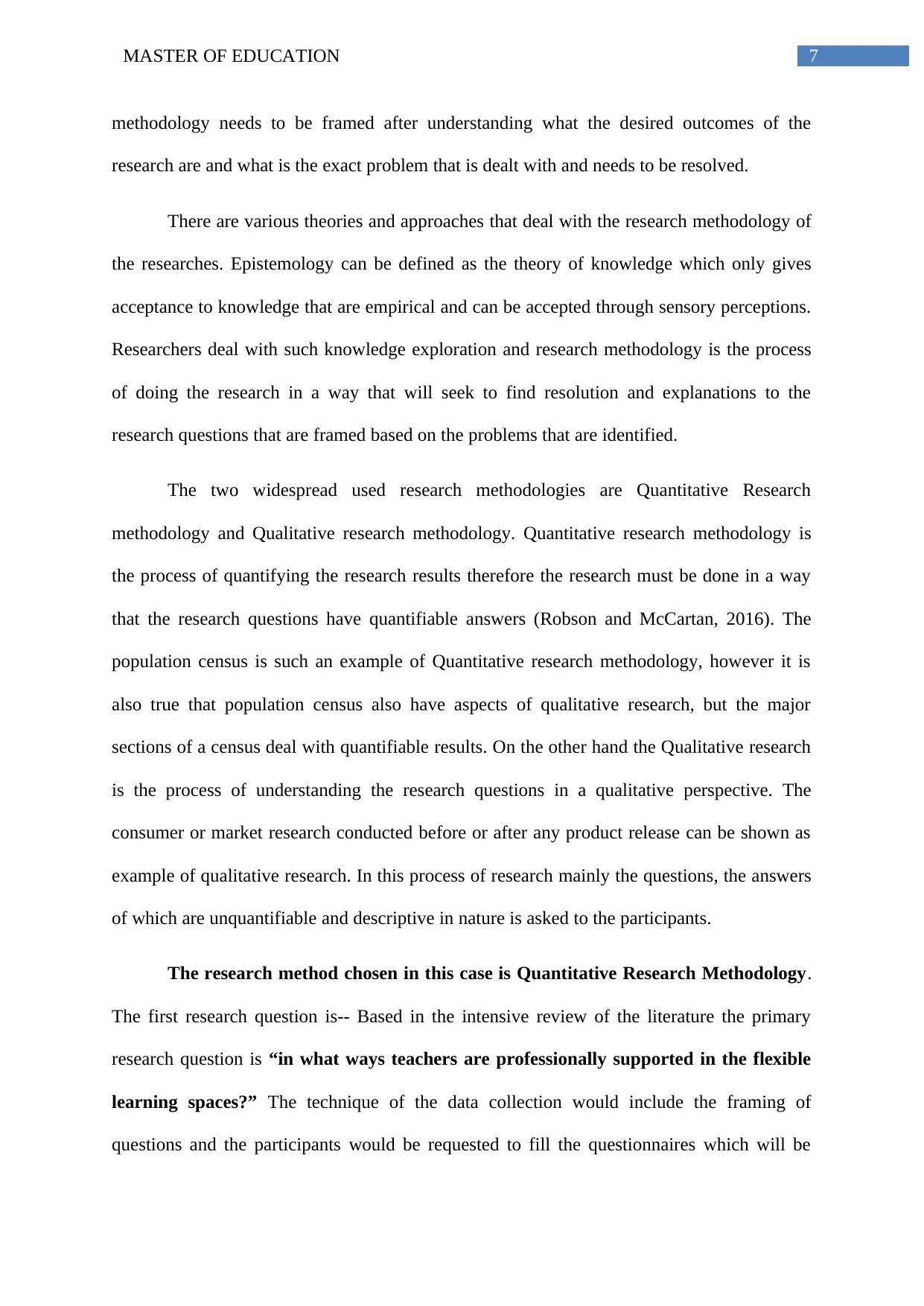
7MASTER OF EDUCATION
methodology needs to be framed after understanding what the desired outcomes of the
research are and what is the exact problem that is dealt with and needs to be resolved.
There are various theories and approaches that deal with the research methodology of
the researches. Epistemology can be defined as the theory of knowledge which only gives
acceptance to knowledge that are empirical and can be accepted through sensory perceptions.
Researchers deal with such knowledge exploration and research methodology is the process
of doing the research in a way that will seek to find resolution and explanations to the
research questions that are framed based on the problems that are identified.
The two widespread used research methodologies are Quantitative Research
methodology and Qualitative research methodology. Quantitative research methodology is
the process of quantifying the research results therefore the research must be done in a way
that the research questions have quantifiable answers (Robson and McCartan, 2016). The
population census is such an example of Quantitative research methodology, however it is
also true that population census also have aspects of qualitative research, but the major
sections of a census deal with quantifiable results. On the other hand the Qualitative research
is the process of understanding the research questions in a qualitative perspective. The
consumer or market research conducted before or after any product release can be shown as
example of qualitative research. In this process of research mainly the questions, the answers
of which are unquantifiable and descriptive in nature is asked to the participants.
The research method chosen in this case is Quantitative Research Methodology.
The first research question is-- Based in the intensive review of the literature the primary
research question is “in what ways teachers are professionally supported in the flexible
learning spaces?” The technique of the data collection would include the framing of
questions and the participants would be requested to fill the questionnaires which will be
methodology needs to be framed after understanding what the desired outcomes of the
research are and what is the exact problem that is dealt with and needs to be resolved.
There are various theories and approaches that deal with the research methodology of
the researches. Epistemology can be defined as the theory of knowledge which only gives
acceptance to knowledge that are empirical and can be accepted through sensory perceptions.
Researchers deal with such knowledge exploration and research methodology is the process
of doing the research in a way that will seek to find resolution and explanations to the
research questions that are framed based on the problems that are identified.
The two widespread used research methodologies are Quantitative Research
methodology and Qualitative research methodology. Quantitative research methodology is
the process of quantifying the research results therefore the research must be done in a way
that the research questions have quantifiable answers (Robson and McCartan, 2016). The
population census is such an example of Quantitative research methodology, however it is
also true that population census also have aspects of qualitative research, but the major
sections of a census deal with quantifiable results. On the other hand the Qualitative research
is the process of understanding the research questions in a qualitative perspective. The
consumer or market research conducted before or after any product release can be shown as
example of qualitative research. In this process of research mainly the questions, the answers
of which are unquantifiable and descriptive in nature is asked to the participants.
The research method chosen in this case is Quantitative Research Methodology.
The first research question is-- Based in the intensive review of the literature the primary
research question is “in what ways teachers are professionally supported in the flexible
learning spaces?” The technique of the data collection would include the framing of
questions and the participants would be requested to fill the questionnaires which will be
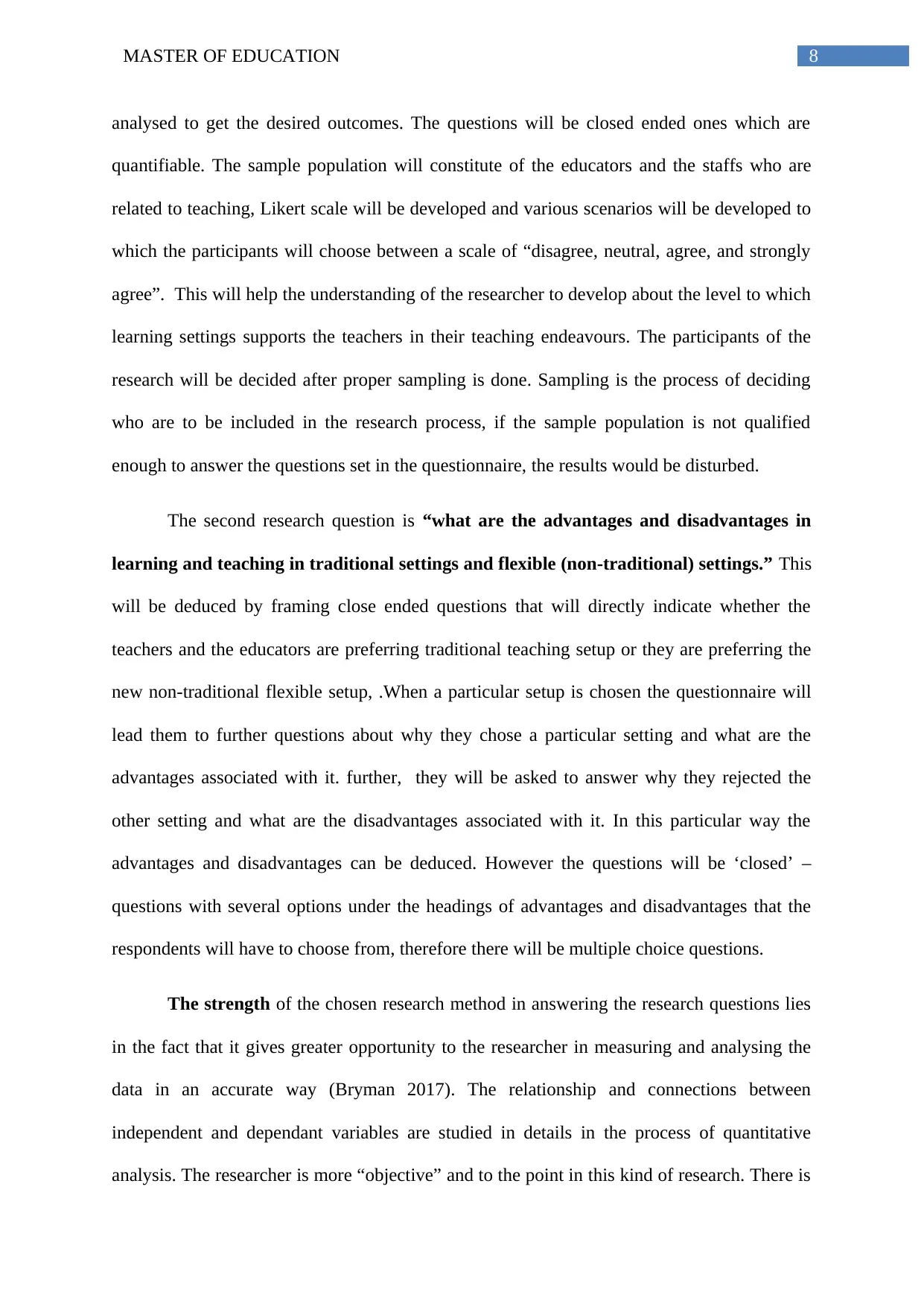
8MASTER OF EDUCATION
analysed to get the desired outcomes. The questions will be closed ended ones which are
quantifiable. The sample population will constitute of the educators and the staffs who are
related to teaching, Likert scale will be developed and various scenarios will be developed to
which the participants will choose between a scale of “disagree, neutral, agree, and strongly
agree”. This will help the understanding of the researcher to develop about the level to which
learning settings supports the teachers in their teaching endeavours. The participants of the
research will be decided after proper sampling is done. Sampling is the process of deciding
who are to be included in the research process, if the sample population is not qualified
enough to answer the questions set in the questionnaire, the results would be disturbed.
The second research question is “what are the advantages and disadvantages in
learning and teaching in traditional settings and flexible (non-traditional) settings.” This
will be deduced by framing close ended questions that will directly indicate whether the
teachers and the educators are preferring traditional teaching setup or they are preferring the
new non-traditional flexible setup, .When a particular setup is chosen the questionnaire will
lead them to further questions about why they chose a particular setting and what are the
advantages associated with it. further, they will be asked to answer why they rejected the
other setting and what are the disadvantages associated with it. In this particular way the
advantages and disadvantages can be deduced. However the questions will be ‘closed’ –
questions with several options under the headings of advantages and disadvantages that the
respondents will have to choose from, therefore there will be multiple choice questions.
The strength of the chosen research method in answering the research questions lies
in the fact that it gives greater opportunity to the researcher in measuring and analysing the
data in an accurate way (Bryman 2017). The relationship and connections between
independent and dependant variables are studied in details in the process of quantitative
analysis. The researcher is more “objective” and to the point in this kind of research. There is
analysed to get the desired outcomes. The questions will be closed ended ones which are
quantifiable. The sample population will constitute of the educators and the staffs who are
related to teaching, Likert scale will be developed and various scenarios will be developed to
which the participants will choose between a scale of “disagree, neutral, agree, and strongly
agree”. This will help the understanding of the researcher to develop about the level to which
learning settings supports the teachers in their teaching endeavours. The participants of the
research will be decided after proper sampling is done. Sampling is the process of deciding
who are to be included in the research process, if the sample population is not qualified
enough to answer the questions set in the questionnaire, the results would be disturbed.
The second research question is “what are the advantages and disadvantages in
learning and teaching in traditional settings and flexible (non-traditional) settings.” This
will be deduced by framing close ended questions that will directly indicate whether the
teachers and the educators are preferring traditional teaching setup or they are preferring the
new non-traditional flexible setup, .When a particular setup is chosen the questionnaire will
lead them to further questions about why they chose a particular setting and what are the
advantages associated with it. further, they will be asked to answer why they rejected the
other setting and what are the disadvantages associated with it. In this particular way the
advantages and disadvantages can be deduced. However the questions will be ‘closed’ –
questions with several options under the headings of advantages and disadvantages that the
respondents will have to choose from, therefore there will be multiple choice questions.
The strength of the chosen research method in answering the research questions lies
in the fact that it gives greater opportunity to the researcher in measuring and analysing the
data in an accurate way (Bryman 2017). The relationship and connections between
independent and dependant variables are studied in details in the process of quantitative
analysis. The researcher is more “objective” and to the point in this kind of research. There is
⊘ This is a preview!⊘
Do you want full access?
Subscribe today to unlock all pages.

Trusted by 1+ million students worldwide
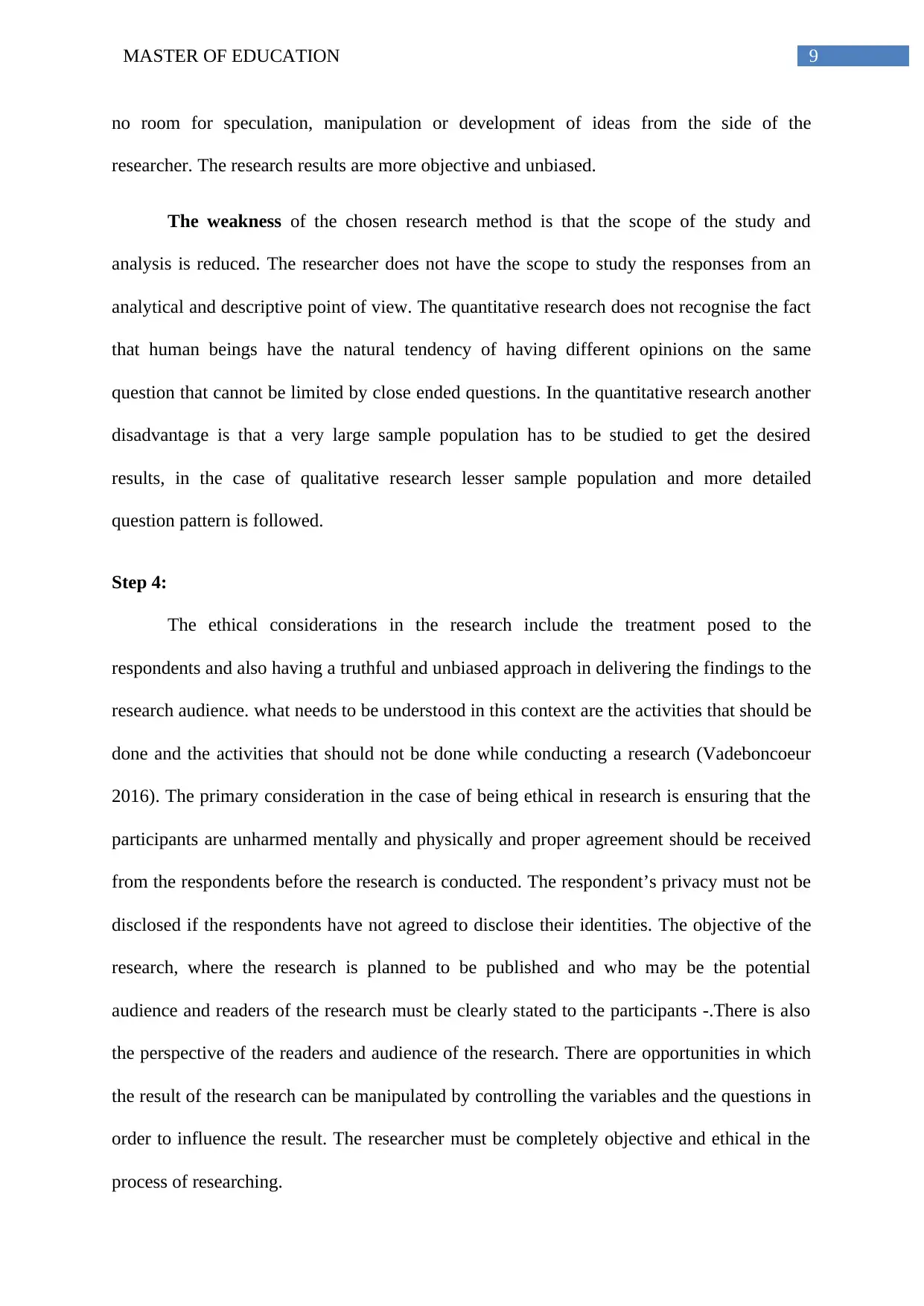
9MASTER OF EDUCATION
no room for speculation, manipulation or development of ideas from the side of the
researcher. The research results are more objective and unbiased.
The weakness of the chosen research method is that the scope of the study and
analysis is reduced. The researcher does not have the scope to study the responses from an
analytical and descriptive point of view. The quantitative research does not recognise the fact
that human beings have the natural tendency of having different opinions on the same
question that cannot be limited by close ended questions. In the quantitative research another
disadvantage is that a very large sample population has to be studied to get the desired
results, in the case of qualitative research lesser sample population and more detailed
question pattern is followed.
Step 4:
The ethical considerations in the research include the treatment posed to the
respondents and also having a truthful and unbiased approach in delivering the findings to the
research audience. what needs to be understood in this context are the activities that should be
done and the activities that should not be done while conducting a research (Vadeboncoeur
2016). The primary consideration in the case of being ethical in research is ensuring that the
participants are unharmed mentally and physically and proper agreement should be received
from the respondents before the research is conducted. The respondent’s privacy must not be
disclosed if the respondents have not agreed to disclose their identities. The objective of the
research, where the research is planned to be published and who may be the potential
audience and readers of the research must be clearly stated to the participants -.There is also
the perspective of the readers and audience of the research. There are opportunities in which
the result of the research can be manipulated by controlling the variables and the questions in
order to influence the result. The researcher must be completely objective and ethical in the
process of researching.
no room for speculation, manipulation or development of ideas from the side of the
researcher. The research results are more objective and unbiased.
The weakness of the chosen research method is that the scope of the study and
analysis is reduced. The researcher does not have the scope to study the responses from an
analytical and descriptive point of view. The quantitative research does not recognise the fact
that human beings have the natural tendency of having different opinions on the same
question that cannot be limited by close ended questions. In the quantitative research another
disadvantage is that a very large sample population has to be studied to get the desired
results, in the case of qualitative research lesser sample population and more detailed
question pattern is followed.
Step 4:
The ethical considerations in the research include the treatment posed to the
respondents and also having a truthful and unbiased approach in delivering the findings to the
research audience. what needs to be understood in this context are the activities that should be
done and the activities that should not be done while conducting a research (Vadeboncoeur
2016). The primary consideration in the case of being ethical in research is ensuring that the
participants are unharmed mentally and physically and proper agreement should be received
from the respondents before the research is conducted. The respondent’s privacy must not be
disclosed if the respondents have not agreed to disclose their identities. The objective of the
research, where the research is planned to be published and who may be the potential
audience and readers of the research must be clearly stated to the participants -.There is also
the perspective of the readers and audience of the research. There are opportunities in which
the result of the research can be manipulated by controlling the variables and the questions in
order to influence the result. The researcher must be completely objective and ethical in the
process of researching.
Paraphrase This Document
Need a fresh take? Get an instant paraphrase of this document with our AI Paraphraser
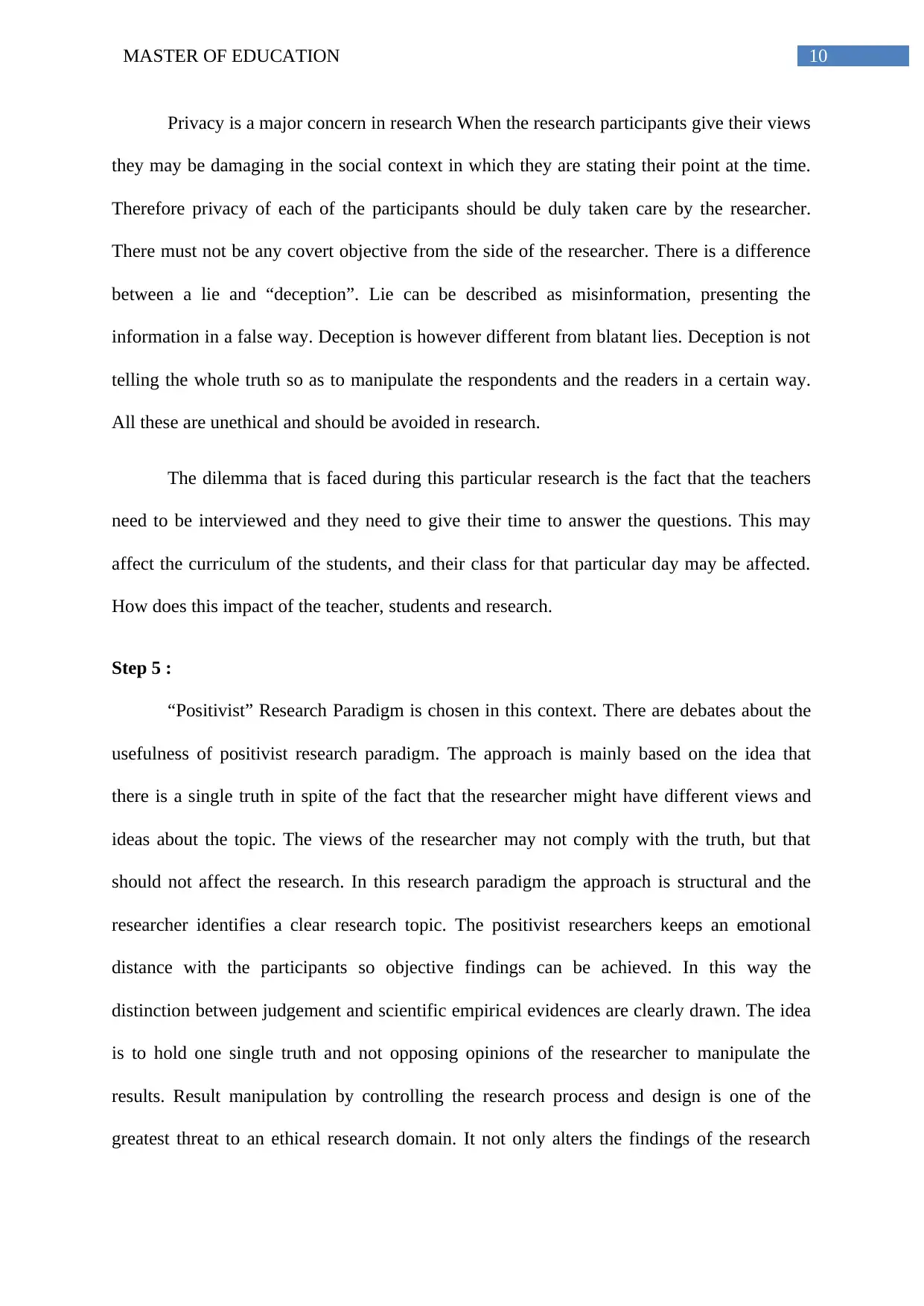
10MASTER OF EDUCATION
Privacy is a major concern in research When the research participants give their views
they may be damaging in the social context in which they are stating their point at the time.
Therefore privacy of each of the participants should be duly taken care by the researcher.
There must not be any covert objective from the side of the researcher. There is a difference
between a lie and “deception”. Lie can be described as misinformation, presenting the
information in a false way. Deception is however different from blatant lies. Deception is not
telling the whole truth so as to manipulate the respondents and the readers in a certain way.
All these are unethical and should be avoided in research.
The dilemma that is faced during this particular research is the fact that the teachers
need to be interviewed and they need to give their time to answer the questions. This may
affect the curriculum of the students, and their class for that particular day may be affected.
How does this impact of the teacher, students and research.
Step 5 :
“Positivist” Research Paradigm is chosen in this context. There are debates about the
usefulness of positivist research paradigm. The approach is mainly based on the idea that
there is a single truth in spite of the fact that the researcher might have different views and
ideas about the topic. The views of the researcher may not comply with the truth, but that
should not affect the research. In this research paradigm the approach is structural and the
researcher identifies a clear research topic. The positivist researchers keeps an emotional
distance with the participants so objective findings can be achieved. In this way the
distinction between judgement and scientific empirical evidences are clearly drawn. The idea
is to hold one single truth and not opposing opinions of the researcher to manipulate the
results. Result manipulation by controlling the research process and design is one of the
greatest threat to an ethical research domain. It not only alters the findings of the research
Privacy is a major concern in research When the research participants give their views
they may be damaging in the social context in which they are stating their point at the time.
Therefore privacy of each of the participants should be duly taken care by the researcher.
There must not be any covert objective from the side of the researcher. There is a difference
between a lie and “deception”. Lie can be described as misinformation, presenting the
information in a false way. Deception is however different from blatant lies. Deception is not
telling the whole truth so as to manipulate the respondents and the readers in a certain way.
All these are unethical and should be avoided in research.
The dilemma that is faced during this particular research is the fact that the teachers
need to be interviewed and they need to give their time to answer the questions. This may
affect the curriculum of the students, and their class for that particular day may be affected.
How does this impact of the teacher, students and research.
Step 5 :
“Positivist” Research Paradigm is chosen in this context. There are debates about the
usefulness of positivist research paradigm. The approach is mainly based on the idea that
there is a single truth in spite of the fact that the researcher might have different views and
ideas about the topic. The views of the researcher may not comply with the truth, but that
should not affect the research. In this research paradigm the approach is structural and the
researcher identifies a clear research topic. The positivist researchers keeps an emotional
distance with the participants so objective findings can be achieved. In this way the
distinction between judgement and scientific empirical evidences are clearly drawn. The idea
is to hold one single truth and not opposing opinions of the researcher to manipulate the
results. Result manipulation by controlling the research process and design is one of the
greatest threat to an ethical research domain. It not only alters the findings of the research
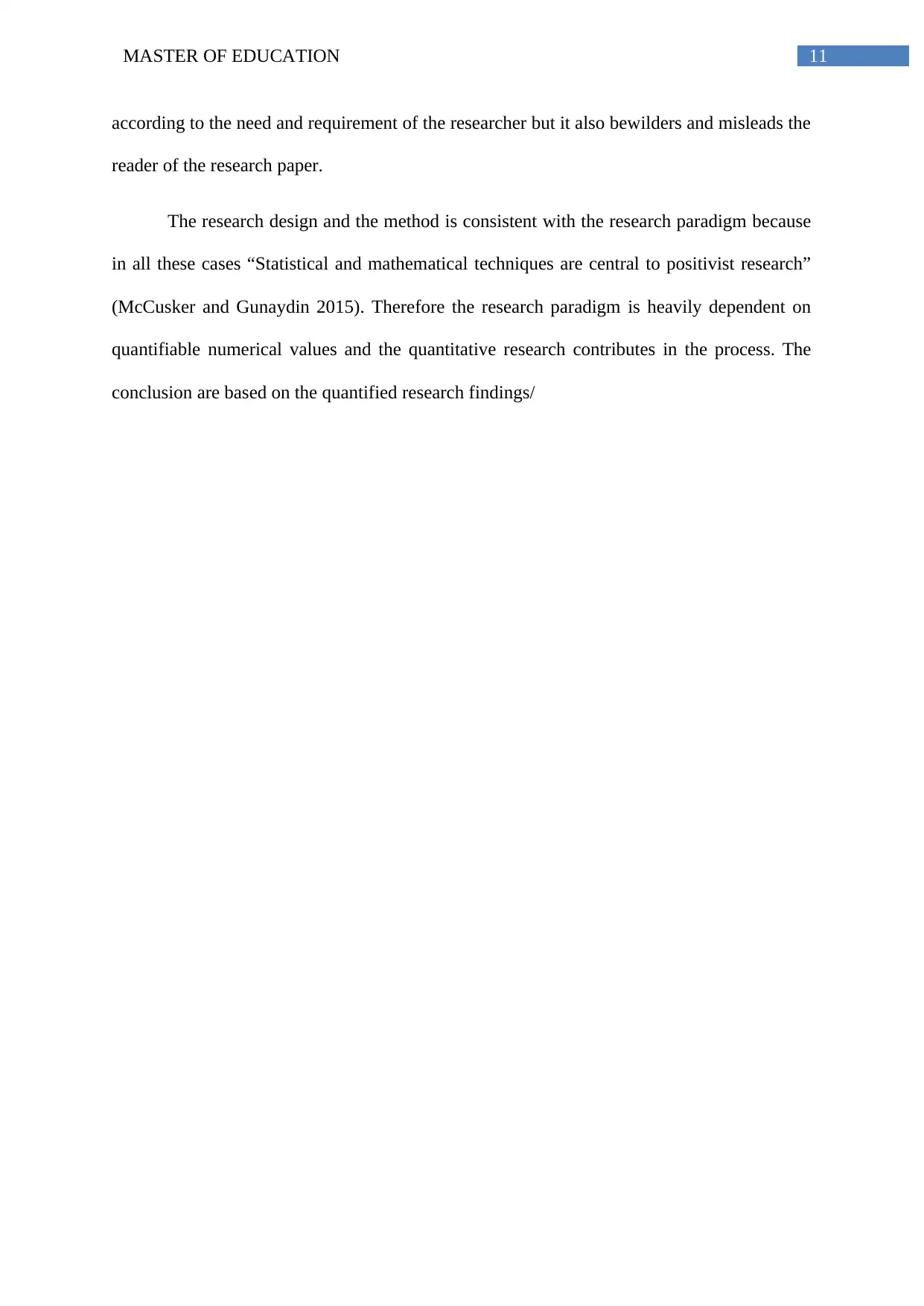
11MASTER OF EDUCATION
according to the need and requirement of the researcher but it also bewilders and misleads the
reader of the research paper.
The research design and the method is consistent with the research paradigm because
in all these cases “Statistical and mathematical techniques are central to positivist research”
(McCusker and Gunaydin 2015). Therefore the research paradigm is heavily dependent on
quantifiable numerical values and the quantitative research contributes in the process. The
conclusion are based on the quantified research findings/
according to the need and requirement of the researcher but it also bewilders and misleads the
reader of the research paper.
The research design and the method is consistent with the research paradigm because
in all these cases “Statistical and mathematical techniques are central to positivist research”
(McCusker and Gunaydin 2015). Therefore the research paradigm is heavily dependent on
quantifiable numerical values and the quantitative research contributes in the process. The
conclusion are based on the quantified research findings/
⊘ This is a preview!⊘
Do you want full access?
Subscribe today to unlock all pages.

Trusted by 1+ million students worldwide
1 out of 14
Your All-in-One AI-Powered Toolkit for Academic Success.
+13062052269
info@desklib.com
Available 24*7 on WhatsApp / Email
![[object Object]](/_next/static/media/star-bottom.7253800d.svg)
Unlock your academic potential
Copyright © 2020–2025 A2Z Services. All Rights Reserved. Developed and managed by ZUCOL.


